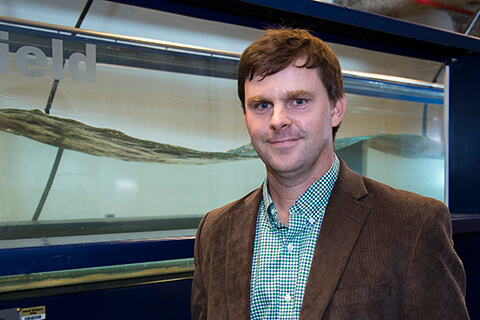Did You Know?: Christopher and Susan Burke Hydraulics and Hydrology Research and Teaching Laboratory
September 17, 2015
 |
|
Cary Troy, an associate professor of civil engineering specializing in hydraulics and hydrology, stands in front of a research flume in the Christopher and Susan Burke Hydraulics and Hydrology Research and Teaching Laboratory in the basement and ground floor of the Civil Engineering Building. Since its dedication in 2010, the lab has been facilitating cutting-edge experimental work in areas related to civil engineering hydraulics. (Purdue University photo/Mark Simons) |
Students and researchers interested in the mechanics of water flow don't need to leave Indiana to test their theories; they only need to walk to the north side of campus.
Since its dedication in 2010, the Christopher and Susan Burke Hydraulics and Hydrology Research and Teaching Laboratory, located in the basement and ground floor of the Civil Engineering Building, has been facilitating cutting-edge experimental work in areas related to civil engineering hydraulics.
The lab's interactive waterfall, functioning water channels, wavemaker and suite of acoustic and laser-based optical instrumentation for flow visualization, flow measurements and field measurements allow students and faculty to perform controlled experiments in real-time.
"If you want to learn about fluid mechanics, you have to stare at moving fluids," says Cary Troy, an associate professor of civil engineering specializing in hydraulics and hydrology. "There's no substitute for intuition, and there's no way to gain intuition in fluid mechanics if you don't spend time in the lab or on the beach."
The Elementary Hydraulics Laboratory class, CE343, uses the wet-lab the most frequently, but any class can use the facility if there is a need. "The theme is water research, basically, and if people have ideas for experiments we try to accommodate them," Troy says.
The wet classroom is designed as a hybrid classroom that falls somewhere between a regular classroom and a lab. It allows instructors to do wet demonstrations while students work on small projects and wander in and out of the regular part of the teaching lab.
Undergraduate students commonly work in the lab as part of the Summer Undergraduate Research Fellowship (SURF) program, and many graduate students have done their thesis experiments in the facility.
Troy recently partnered with some faculty members from Mechanical Engineering and is working to add another feature to the already impressive lab. By overhauling a 150-foot-long water tank kept in the basement, they will be able to large-tow objects through water at speeds as high as four meters per second. They also plan on placing a massive wave generator on one end, which will allow the basin to serve as a large wave tank.
"Stay tuned for this project to be completed," Troy says. "It has the potential to become a truly unique facility, with tons of research applications."
* Purdue's Lyles School of Civil Engineering will hold an open house geared toward current first-year engineering students, prospective students and their families from 2 to 8 p.m. Friday (Sept. 18) in Hampton Hall of Civil Engineering. More information is here.
Writer: Emily Sigg, 765-494-4719, esigg@purdue.edu

